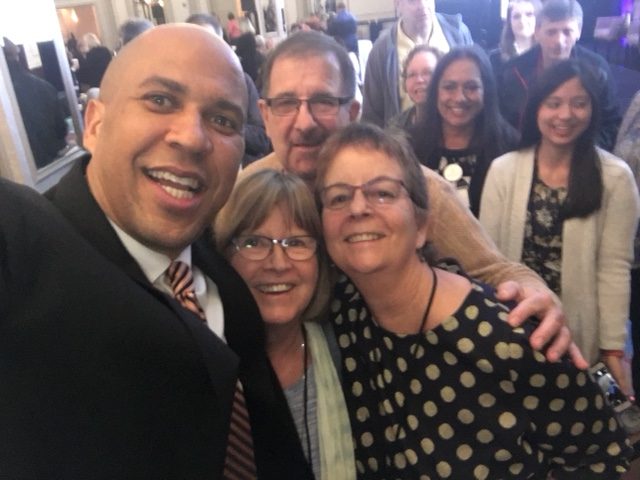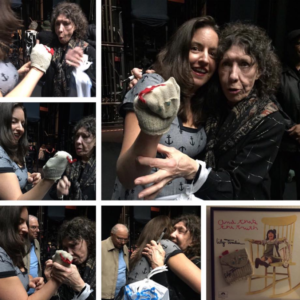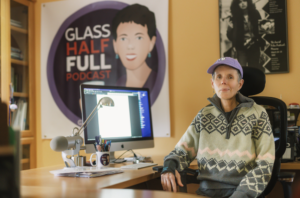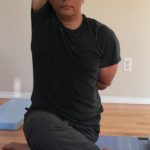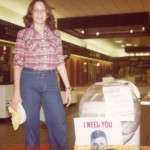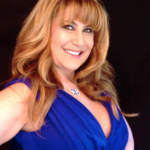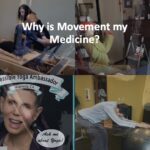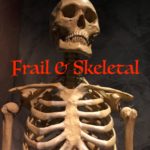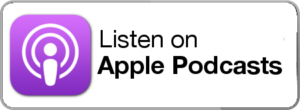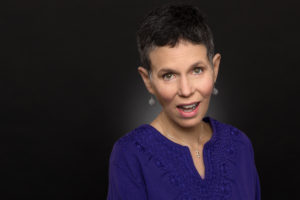Maybe you have a firm grasp on what Patient Advocacy is all about? This episode explores different ways people with disabilities, their allies, and their caregivers practice advocacy. Whether you’re searching for the best healthcare options, leading a support group, mentoring newbies, meeting with legislators, or using social media to get a message out — it’s all about advocacy.

Nancy and her friends meet Senator Cory Booker at a national Parkinson’s Disease Advocacy Conference
Nancy Husari, a retired college instructor with Parkinson’s disease, felt empowered by her advocacy experiences at California’s state capitol and in Washington, DC. Brook McCall, Grassroots Advocacy Manager for the United Spinal Association talks about her work. Marla Murasko, a Down Syndrome Mom Advocate, shares her advice and experience using social media platforms for advocacy. Nina G., comedian, professional speaker, storyteller, writer and educator, discusses how to be a disability ally.
Loose Transcription
Hello and welcome to our episode about Advocacy. I’ve been thinking about this topic for a few months and have asked previous podcast guests about it – how do they define advocacy and what actions do they take toward advocacy – because I believe advocacy can have multiple interpretations. There is no one correct answer. This episode didn’t gel for me until I heard about a friend who went to Washington, DC for an advocacy conference. More on that friend later.
I admit that perhaps my first idea of advocacy included images of going to a state capitol or local offices for government officials, or legislators, and asking for something. Years ago, when I was on my city’s library board, I did just that with a group of library-loving citizens. It was informative but it didn’t jazz me. Perhaps I lack that type of advocacy in my DNA? Not that I question its importance but…I’ve found my inclination toward helping my fellow patients – my community – a more suitable endeavor.
Just what is an Advocate? The dictionary definition says an advocate is someone who speaks or writes in favor of something…they recommend something publicly. My life as an advocate began when I assumed the role of support group facilitator. I began to learn more about neuromuscular disease and how it impacts others – patients with different conditions than mine, their caregivers and families. I listened to these stories and integrated them with my own story and experience and over the years have helped to create programs and opportunities to not just suit my needs and desires but perhaps others who may not have the energy or opportunity to advocate for themselves.
It is my hope that through the stories of my four guests you’ll learn about advocacy efforts that may be suitable for you. Not everyone can go to Washington DC and speak with senators but perhaps you can write a letter, make a phone call, use social media, or cultivate a network of allies?
The first guest is my friend, Nancy Husari. I know Nancy from my local community here in Alameda. We met at a yoga class years ago and she’s in my book club. Nancy is a recently retired community college instructor. I asked Nancy if she calls herself an artist and her response – in line with her whimsically dry sense of humor – is that she prefers being called a FLÂNEUSE. That’s F – L – A – N – E – U – S – E with a little thingy over the A. It’s French; I wasn’t familiar with the word. You can look it up. I thought she was referring to the nasal decongestant…but…no.
Nancy was diagnosed with Parkinson’s disease nearly 5 years ago. She didn’t share the news with me until a year or so after her diagnosis. She was still working full-time and her public acknowledgement of the condition took time as I’m sure many of you are all familiar with this process. Here’s our conversation about advocacy.
Nancy
I’ve been political active since the Vietnam war. A big part was through my Union. Lobbying advocacy was with Headwaters Forest when they were cutting down the Redwood trees in 1995. Our union got involved in it. what happened we got involved; the main thing was to divest state retirement teacher’s funds from a corporation. The first time we had cross pollination between labor and environment. They were both being screwed. I ended up being the person to speak in southern California. I was quoted in the newspaper. I saw a small group of people can really make a difference. You don’t really have to know anything or be an expert. All you have to do is show up and try. Later that turned in…I saw how we got what we wanted there. When the opportunity came for me to get involved with Parkinson’s, it was a natural fit for me.
I was too busy having Parkinson’s, working, and commuting. It’s a natural fit for me. What is advocacy? To me it takes political action into a specific realm with communication with our legislators…specific asks about policy. For me it means face-to-face meetings with staffers and legislatures. Advocacy does have all those meanings. My cat has small cell lymphoma and I am acting as his advocate. We all need an advocate to help us through the healthcare system. We’re doing it as a community.
what was your engagement with the structure, Parkinson’s disease organizational structure? We’re really lucky in the east bay to have PD Active – it’s not political like Michael J. Fox is. PD Active has a good support group, has a lot of exercise classes, and getting into a mentoring system. So people who are newly diagnosed have someone to show them the ropes. I needed that. I put it together piecemeal for myself. I would say I started this before going to Washington DC, I unofficially act as a mentor. I tell them about the options, medications, support groups…I think I pretty much covered it. I believe people have to take that first step. Get a moving disorder specialist. I just paid for a third opinion. There’s no diagnosis for Parkinson’s; there’s no bio marker. Only get an autopsy. It’s connected to advocacy work. I talk to people about exercise because that’s really important with Parkinsons; it’s not just everyone should get exercise. It’s as important as the drugs. Also just being an example telling people when they are first diagnosed they’re going to be really upset. But for me it has gotten better. I’m still able to do what I want to do…but I used to be able to put on a backpack…long hike for me is 5 miles. It’s not the end of the world. That’s how I see my role as an unofficial mentor to people. It was called Parkinson’s Policy Forum and run through MJF Foundation. It was really a great experience. I got an email from…do you want to apply for the forum? I did not think I would be accepted. I didn’t know anyone that would write that letter. I mentioned that I did lobbying in Sacramento. I was accepted. It was well organized, speakers, they taught us general things…Cory Booker spoke about his father who had Parkinson’s. they told us the Dos and Don’ts. It was empowering to be in a room with hundreds of people who have the same disability that I have. Maybe some were in wheelchairs. You have on and off periods. When the meds wear off, you really feel it. I saw a group of dynamic people that you didn’t need to explain things to. It was uplifting, energizing. I like being around people with the same disability and are real go-getters, being the same people they were before.
In an earlier podcast episode exploring how weather affects our health, I spoke with Brook McCall. Brook is the Grassroots Advocacy Manager for the organization United Spinal Association. During that conversation, I took the opportunity to ask Brook what advocacy means for her.
Brook
I am working with the United Spinal…it’s a relatively new program. A network. We have someone in most states. Point person for advocacy. Make connections with legislators, working relationships going forward. Advocacy is an awareness. It’s anything we’re doing to make people understand what we need for our unique lives. Making sure we have allies. People know…simple things out there to make our lives better. [what was your path to becoming a vocal advocate?] agreed! I’ve been amazed lately. For me it was a slower process. When I was in the hospital for my injury; it was the first time I was in a hospital. I learned about the insurance system. I was mind-boggled. I had family, resources. I empathize the same things are being navigated by people without the resources. I just ended up going back to school, I studied public health. How many more advocates are needed? You need to speak to the policy makers. I remember that conversation. Over the years I’ve been able to get more involved.
Brook mentioned allies. The term, disability ally, also came up during my conversation with Nina G. Nina G. was featured in our previous episode, laughter is the best medicine, because Nina is a stand-up comic. But Nina wears many hats in addition to being a comedian – she is a professional speaker, storyteller, writer and educator. Nina, who grew up with a learning disability and is a stutterer, brings her humor to help people confront and understand disability culture, access, and empowerment. She is certainly an Advocate for the disabled community so I asked her to explain the term, disability ally.
Nina
What is a disability ally? I have two friends – Hope and Elizabeth – how to be an ally for someone who stutters. If you want to be an ally to someone with a disability, you ask how do you want me to help? a big part of it to look at yourself and why do I want to be an ally. Is it about me? Steve Danner is a little person. We went to Seattle we went to NBC stand up for diversity which neither of us advanced on; what I noticed when we were everywhere people started at him. They get stared at constantly. This was so friggin awful. I started to stare at the people who were staring at him. I’m making this about me. This is me being angry. We talked about it. we want to be an ally to different people, in different groups. I think it needs to come down to genuine places. A drunk comic said to me…Dave sat there and was annoyed for me. He explained it’s a brain thing and has nothing to do with you. that to me is being an ally and they can just take it because it’s a relationship they have.
Each of these guests you’ve heard from has a disability. You don’t have to have a disability to advocate on behalf of people with disabilities. Like Nina described, there are disability allies. And there are also caregivers who make advocacy one of their goals. Marla Murasko is a Down Syndrome Mom Advocate and Inclusion Influencer. She uses social media as her main form of advocacy.
Marla
I started out with Facebook. That’s where my community was – mothers of children with Down’s syndrome. Social media is constantly changing. Instagram being visual; I need to share my message of inclusion, it’s easier for me to do it on Instagram. Drive people back to your blog. Instagram stories. Use it to bring real life to your blog. I’m connecting more and having more intimate relationships with families on Instagram. Businesses are drawn to it. I feel I need to be. I do Facebook Lives. The patient leader or advocate…
I think LinkedIn can be vital to health advocates if they are looking to connect with companies, health industry leaders. Share stories on, may get organizations to collaborate with you. they may invite you to speak at events. Have a presence on LinkdedIn. I’m taking what I put on my blog I put it on LinkedIn.
I’d love to hear from listeners about their advocacy experiences. Feel free to comment on the podcast notes for this episode on the Glass Half Full website. I’m sure we haven’t covered all the ways people can advocate for themselves or their loved ones.
No matter how you choose to express yourself as an Advocate I think it means taking the next step from being alone with your condition or disability. Stepping outside yourself, perhaps outside your comfort zone. You may never aspire to visit your State Capitol to speak with legislators but don’t dismiss it as a possibility. Here are some final words from Nancy and they are definitely motivational…
Nancy
I would encourage anyone who knows and loves someone with a neurological disease to get involved with advocacy whether it’s just signing letters, staying informed. From my experience, it really works. The more personal the interaction is…an email is great…face to face…I’m getting a lot of bang for my democratic buck. They really do what people say. They’re open to the constituents. Pictures are good. …when you see the off periods, it’s really devastating

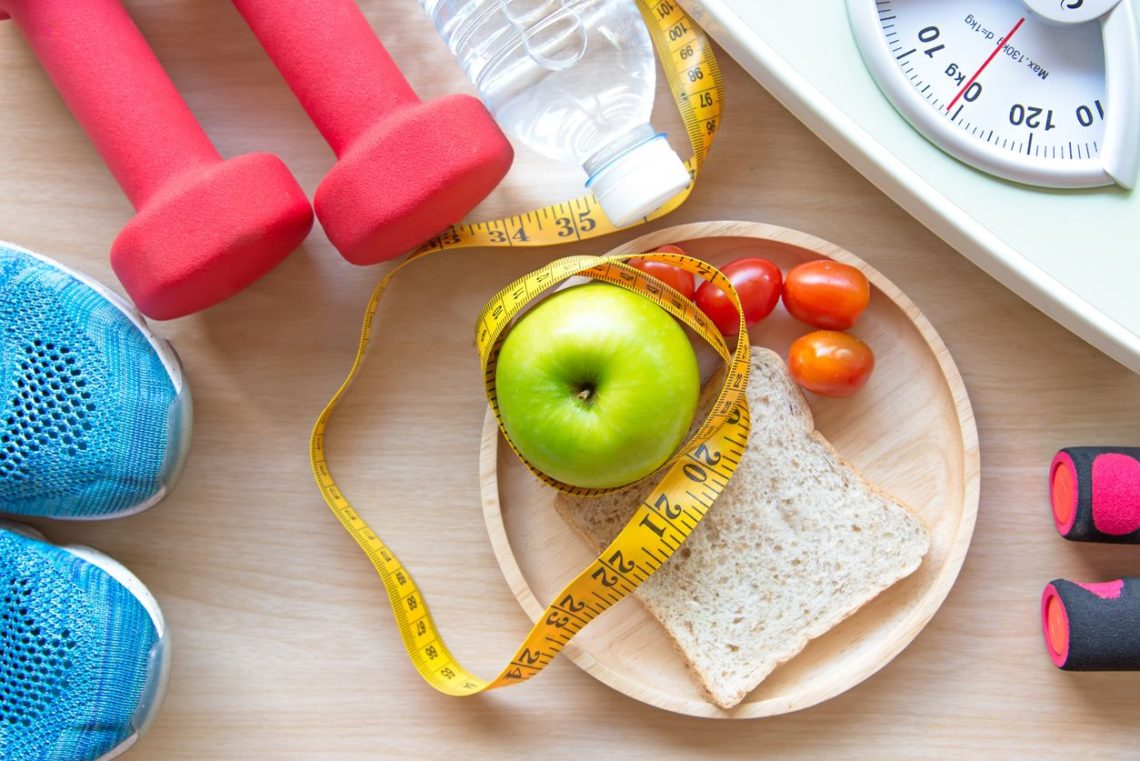


 How do you give back? In previous podcast episodes we heard from
How do you give back? In previous podcast episodes we heard from 



